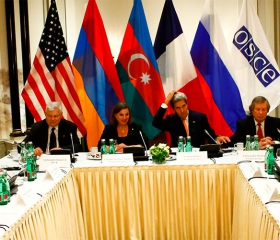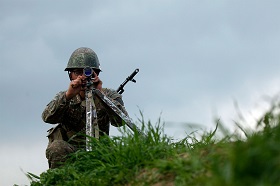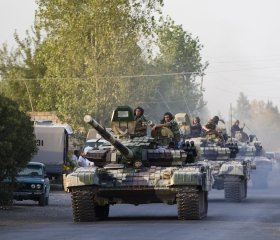Discussion
Touring Nagorno Karabakh with a group of international journalists in early May, I walked in the ruins of townhouses in Mardakert district to rethink the conflict resolution “mantras” that experts and mediators have been repeating year after year since 1990s. The truth is, that it’s well beyond political will, vision and courage to embark on such a process when there is zero trust among the parties in the conflict, more so after the alleged war crimes during the Four Day War that now, properly itemised in folders, are being channeled to international courts.
The use of heavy weaponry against civilian targets until April 28-29 nullified the personal chemistry between negotiators and widened the gap between the sides to agree upon the Basic Principles consistently advertised by the mediators for a few years.
While shepherds are still continuing to discover parts of Smerch and Grad rockets in the Nagorno Karabakh battlefields, the Foreign Ministers of Armenia and Azerbaijan scheduled separate meetings in Brussels and Paris on May 31 and June 2 with the Co-Chairs of the OSCE Minsk Group - the international mediators charged to actually shepherd the sides to a negotiated settlement. These gentlemen are now working to prepare “substantial negotiations”, to quote Russian Foreign Minister Sergey Lavrov, between Serzh Sargsyan and Ilham Aliyev marked in calendars for “late June”. In these meetings the Foreign Ministers were equipped with “expert-level elaborated ideas”, or drafts, about the implementation of Vienna agreements, precisely about the so-called incidents investigation mechanisms. The first, and still the only post-war meeting of Presidents of Armenia and Azerbaijan, moderated by John Kerry, Sergey Lavrov and Harlem Desir (one-of-a-kind high-level gathering as such in a long time) on May 16 in Vienna, produced few crucial agreements in order “to reduce the risk of further violence”. Apart from invoking international obligations for respecting the ceasefire regime and exchanging POWs and missing persons, sides agreed to establish an OSCE investigative mechanism and expand the existing Office of the Personal Representative of the OSCE Chairman-in-Office Andrzej Kasprzyk, presumably within his existing mandate. President Serzh Sargsyan of Armenia confirmed his readiness to embark on inclusive implementation of Vienna agreements en route to Yerevan. After initially denying knowledge of any deal, Azerbaijan later on committed later on.
Interestingly, Nagorno Karabakh authorities expressed “optimism”, but underlined that they should have a seat around the table “to implement Vienna agreements”, as a full-fledged party in ceasefire agreements of 1994-95 and one that has due acknowledgement both in UNSC resolutions of 1993 and CSCE Budapest Summit decisions of 1994.
The issue of having Nagorno Karabakh representatives around the table has been in the air for a while, with Azerbaijan fiercely denying such a possibility, and Minsk Group mediators promising it after document on Basic Principles is signed, despite the call for “direct contacts” within the OSCE Minsk Group in the relevant UNSC resolutions, e.g. Resolution 853 (1993).
Still to be brainstormed how the additional monitoring equipment can be installed along the Line of Contact without an express authorization or formal engagement of the Nagorno Karabakh authorities, for a while, however, the incident investigation and expanded presence of OSCE CiO PR’s mission (albeit with the same limited mandate) will guide the peace process to move on (as predicted).
Two stumbling blocks
Ever since the Vienna meeting on May 16, the situation along the First World War-style trenches in the Line of Contact between NKR and Azerbaijan remains calm, with occasional violations of ceasefire, giving space and a rare chance to the white-collar men.
A continued respect for ceasefire regime and steady progress on Vienna agreements will provide space for peace talks to enter a negotiation level, bypassing the populist rhetoric in the air.
And there have always been two packs of issues on the table: first - the future status of unrecognised Nagorno Karabakh Republic and second – the fate of regions around it, occupied by local Armenian troops in the 1992-94 war.
Now, any expert in this conflict, depending on the weather outside and their affiliations, would easily identify a number of problems in the short sentence above, ranging anywhere between challenging the legitimacy and legality of existing statehood for Nagorno Karabakh Republic and issues with regards to withdrawal of local Armenian forces. Shall a publishing editor add commas and replace synonyms here and there, one should better cage in soon not to embrace eggs and tomatoes to their face.
The most crucial issue is the status of the region - to be put on a referendum.
Ahead of Lavrov’s visit to the region in late April, Armenia reminded that “the main requirement of peace process shall be the recognition of independence of [Nagorno Karabakh]”. Azerbaijan continued stressing on the importance of agreeing on phased withdrawal as a precondition for implementation of Vienna agreements.
Around same time the Armenian Deputy Foreign Minister Shavarsh Kocharian confirmed on record that “compromise” solution is still on the table, but after the recent war, “other approaches” shall be applied instead of elements such as “delayed referendum” for determining the final status of Nagorno Karabakh, which earlier was included in the package “to allow face-saving in Baku”.
Leave aside politically-loaded statements, Azerbaijan claims referendums can only be held in the entire territory of the country according to Constitution and domestic laws (thus, will require new amendments to enable resolution as such); while for Armenia there is a parliament resolution, adopted on July 8, 1992, rendering any international agreement even in theory stipulating Nagorno Karabakh Republic within the borders of Azerbaijan as “inadmissible”.
For students of international conflicts, however, it’s clear that any referendum will be held based on the modalities and principles inscribed in the international agreement, not domestic by-laws. And it’s been more or less reflected in one of earliest editions of the Madrid Document, leaked at an Armenian expert blog in April.
For the regions around former Nagorno Karabakh Autonomous Oblast, the public attitude and official rhetoric in Yerevan and Stepanakert have transformed many times (on all but readiness to live in association with Azerbaijan, as polls suggest), whereas in Azerbaijan there had been predictable stability of perceptions, agonised by official propaganda. The “land for peace” philosophy of late-1990s remained largely in place even in the NKR Constitution Article 142 (adopted in 2006), providing for land swap of chunks of Mardakert, Martuni and entire Shahumian region – the original pieces of NKR now under Azerbaijani control – with the regions identified in relevant UNSC resolutions as “occupied”. For now, the April war predictably resulted in hardened positions and rally-round-the-flag in the background, and even an attempt of selling this to public may bear high political costs.
To reconcile domestic politics, rally public support and iron out a workable and legally sound package (if Vienna spirit is here to stay), presumably, the sides will need to create expert-level workgroups, and in fact more people allowed to dive in the process.
A glance on impact onto post-Soviet reintegration
The relations of Armenia, Nagorno Karabakh and Azerbaijan with their allies is something that affects the conflict dynamics and the pace of its resolution.
In the wider region it affects the Kremlin plans to consolidate and reintegrate the post-Soviet space, as now-unfreezing conflict in Nagorno Karabakh threatens fellow Armenia’s security, a CSTO Member-State in its own right. A negative alliance dynamics in EAU and CSTO, as evidenced by Astana’s call to postpone the long-planned EAU high-level meeting in Yerevan shortly after the Four Day War, will do no good to Moscow plans – as others may draw their lessons, too. Speaking at the high-level EAU summit in Astana on May 31, Armenian President Serzh Sargsyan hinted that “a permanent hotbed of tension and discord” on EAU map won’t be bad for Armenia alone, but will reverberate well beyond.
It’s also all but obvious that Baku will ever consider bidding for Eurasian Economic Union membership, which yet again will change its brand-name soon, as Azerbaijan has consistently been backed by Western powers for being an (yet minuscule) alternative to Russian hydrocarbons, not for ranking in Russia-led enterprises.
Therefore, Kazakhstan’s continued alliance with a fellow-Turkic Azerbaijan will continue to weaken formal regional arrangements from within; and this is a challenge that Moscow has to deal with as a leading power.
The utility of deadlines
Shall be momentum reached Vienna be missed, the urgency of finding a compromise will continue to fade away with passage of time. Neither the economic hardships, such as inevitable decline of international investments, will make parties to settle, despite the fact that filthy and effortless oil revenues largely enabled the Four Day War in the first place.
There is a stack of literature on the utility of deadlines in peace processes, most famously developed at fingertips of George Mitchell on Northern Ireland and Richard Holbrooke on Bosnia. No public record of deadlines in Karabakh talks known yet, there have always been milestones that Armenia, Nagorno Karabakh, Azerbaijan, or the mediators themselves, tried to embark on.
It can be inferred from various statements by all parties, as well as frequency of their communication (between Lavrov, Kerry, Ayrault and on other levels), that the “substantial” meeting in June has been urged by the mediators as a milestone event.
There are other deadlines to watch out in the calendar, too.
As of now, the one and most important milestone (no, it’s not the Formula One) in the peace process is perhaps June 16, which marks the 12-month deadline envisaged by the European Court of Human Rights in Chiragov and Others v Armenia and Sargsyan v Azerbaijan cases in Grand Chamber. To refresh, these are two cases before the Grand Chamber dealing with the aftermath of the Nagorno-Karabakh conflict and, among important legal aspects (there is a lot of rhetoric of what actually these cases are about!), raising the question of Armenian and Azerbaijani refugee rights and just compensation. The Strasbourg Court invited the two governments “[to file] their written observations on the matter and, in particular, to notify the Court of any agreement that they may reach” within 12 months period, expiring this week.
While neither Yerevan, nor Baku reported any breakthrough just yet, like any other valuable document in the course of this conflict, ECHR GC judgments on Chiragov and Sargsyan cases are only second to the four UN Security Council resolutions of 1993 in terms of the volume of misinterpretations and fake-expert-analysis flooding the 24/7 essentially free of charge news circle. Only few actually read (highly recommended) Dissenting opinions by the Portuguese Judge Paulo Pinto de Albuquerque to both judgments which, to compare in depth and insight, stand equal to Thomas De Waal’s illuminating account in “Black Garden”, albeit in legal interpretation of the issue.
Whether or not we will see this deadline disregarded (not unprecedented in Court’s history), remains to be seen; yet it’s utility for the peace process shall be questionable at least.
The other red flag (not to be overlooked) is that Armenia will enter an unusual electoral season this Fall for parliamentary elections in Spring 2017 – first after Constitutional Amendments of December 2015 –that may suggest a reshuffle in the national balance of power in the new parliamentary system. In other words, this is another milestone that shall load minds of mediators (not to mention U.S. elections, of course) to use the “window of opportunity”, if there is one.
One point is clear.
Economic hardships are not likely to produce mutually hurting stalemate for any of the sides involved in Nagorno Karabakh conflict. Although Azerbaijan sees its worst fears coming true with thinning oil revenues, and Armenia and Nagorno Karabakh see a steep downslide in foreign investments together with still-low revenues on mining, these are unlikely to affect negotiators choice to stick to their well-known positions unless the economic downturn challenges the internal political stability of governments.








